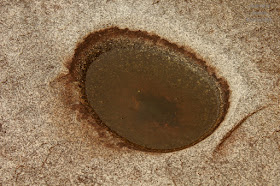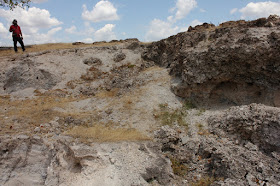Feb 2012 I received an email from an American lady about my visit to Mudgod. Soon we were exchanging emails regularly.. Alexis and her husband Archie were in touch with a monk at Shar Gaden. She also mentioned about her upcoming vacation to Kerala and then a short visit to Mundgod to meet the monk. They had never met him in person and were eager to see him. Since I had plans of visiting Mundgod again, I offered to meet him and send a picture of their monk friend Thupten Dhonden.
July 7, 2012
I and a colleague had plans to see locally popular temples of Adargunchi, Budarsingi and Kundgol. Then we headed towards Mundgod, we went straight to Shar Gaden Monastery administration office. The office managed by monks were friendly; they confirmed that Thupten Dhonden was available. We had tea during the short wait. It was nice to meet Thupten Dhonden, there was something special about him. I mentioned about Alexis and Archie whom he recognised easily. I told him about their upcoming visit; took few pictures; chatted a while and said bye to them. Surely monks have their routines, I can't be holding them up. At extreme left is Malatesh my colleague and in the middle is Thupten and to his right is Palden the administrator.
Then we headed towards Gaden Jangtse Datsang Monastery. This is the western gate of the campus.
We went around the monastery campus but not inside the main building since its doors were closed.
That's the main building with wide open space in the front. During their annual ceremonies the entire open space is occupied by monks in maroon and saffron.. the colors you see on the building's top portion.
A religious symbol made of brick and mortar.
A stage for special occasions.
Painting on the stage backdrop. On the right, of the four figures, the top most is Shankh and bottom most is Chakra.. symbols of Lord Vishnu. Every figure has a lotus, the sacred flower of all Hindu based religions.
We moved on towards Drepung Loseling monastery, I wanted to see the colorful paintings again. Enroute we stopped at the Tibetan marketplace where we bought few shawls and wall hangs. We were famished by the time we reached Drepung Loseling; found a spot under a tree within the monastery campus; relished every item of home packed lunch packed by Malatesh's mother. After feeling rested we were expecting to see the inside of the monastery but unfortunately the monk with keys to the main door did not turn up. Slightly disappointed we left, headed back towards Dharwad.
Jan 3, 2014
Alexis and Archie had arrived at Mundgod. I planned a day trip to meet up with my friends from half way across the globe. I met them at Shar Gaden Monastery guest house; remember taking Thakur Pedha for them. I was introduced to Thomas, a British national who was here to teach English to young monks. The best part was the teacher and students were totally strange to each others' languages :) Yet, Thomas managed to teach them words and phrases.
My friends were happy to be seeing India but they were disappointed about not meeting Thupten Dhonden. He was sent urgently to Tibet for some conference or something. I shared their emotion. As a consolation, we were allowed to see Thupten's hostel room. It was a tidy little room, well kept. The hostel was 3 or 4 floors high; I could see middle age and elderly monks in small groups engrossed in discussions. Also, I got a glimpse of religious debate in process; two debates debating while judges and audience watched over.
Back to the guest house, we had lunch.. soup, rice, noodles and vegetables in Tibetan style. I suggested Alexis and Archie that we make a trip to Drepung Loseling monastery, I wanted them to see the lovely paintings at the entrance. The monks were not keen with my idea but I urged they should see it having come here.
I think Alexis and Archie did like the paintings. Here they are, inside the main building, right in front of the altar.
This is the prayer hall. I guess it can accommodate 500 monks easily. Wonder how it sounds when Buddhist Mantras are chanted in low voices.. the hall would be filled with positive energy.. powerful enough to calm a disturbed mind.. wish I could experience it once. Wish I could spend a fortnight or a month here.
Close to the altar is a scale model of the main building. Yes, we are in this building.
I was glad my friends could see the monastery and that I could spend time with them. Well, it was time to leave; I dropped them back to Shar Gaden; bid them bye and headed back towards Dharwad.
.........


















































